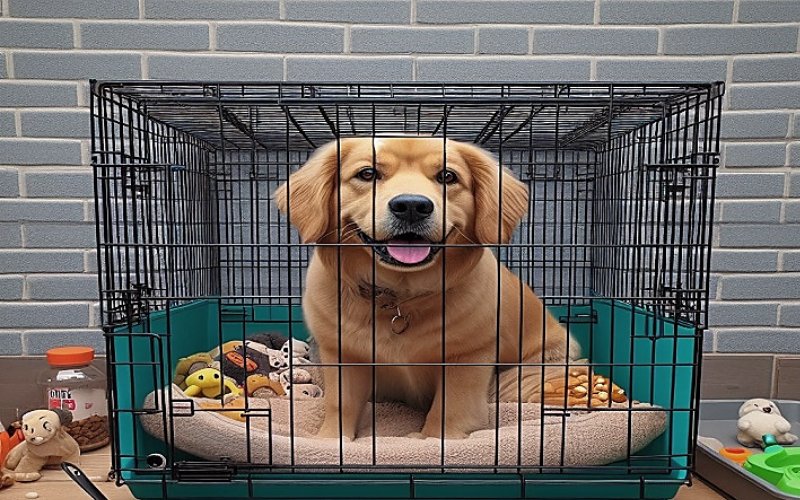Introduction
Have you ever wondered about crate training your dog? You must have got a hint about it from friends or family or even the internet. But what exactly is crate training? And is it really necessary?
Well, let me tell you, crate training can be a fantastic tool for both you and your furry friend. It can help your dog feel safe and secure. It can also make potty training easier, and even reduce separation anxiety.
Why Do You Need A Crate For Your Dog?
But before we dive into the nitty-gritty of crate training, let’s address the elephant in the room: why do we even need crates?
When done correctly, crate training is all about positive reinforcement and creating a space that your dog loves. It’s not about locking them up for hours on end; it’s about giving them a safe and secure place to call their own.
Some Reasons To Crate Train Your Dog
House Training
Dogs like to keep their den clean; it is natural for them. A crate mimics a den environment, making your dog less likely to soil the space inside. Crates can also help you to potty train your dog.
Safety
Crates can help you prevent accidents. If you have to leave your puppy unattended, putting them in a crate will help ensure they don’t have an accident on your furniture or carpet.
Separation Anxiety
Crate training can help your dog learn to be comfortable alone in its crate. This can be helpful if your dog has separation anxiety. Crates can help to reduce your dog’s anxiety when you are not home.
Security
A crate can provide your dog with a safe and secure place to retreat to when they are feeling stressed or overwhelmed.
Relaxation
A crate can be a comfortable place for your dog to relax and rest, especially if it is furnished with a soft bed or blanket.
Travel
Crates can help to reduce your dog’s stress when traveling. By providing them with a familiar and secure space to stay in, crates can help to make travel less stressful for your dog. They can be used in cars, airplanes, and trains.
Training
A crate can be used as a training tool to help teach your dog commands such as sit, stay, and come.
Exercise
By placing puzzle toys or food-dispensing toys inside the crate, you can engage your dog’s mind and encourage it to work for treats or rewards. This mentally stimulating activity not only prevents boredom and destructive behavior but also promotes problem-solving skills.
Confinement
Crates can be used to confine your dog when needed, such as after surgery or when you have guests over. This can help to keep your dog safe and secure.
How To Choose The Right Crate For Your Pup
So, how do you choose the crate that’s best for your dog? Here are some things to look out for:
Size Matters
The size of the crate is paramount for your dog’s comfort and movement. Choose a crate that allows your dog to stand up fully, turn around comfortably, and lie down without their back touching the top of the crate. Avoid oversized crates, as they may encourage your dog to eliminate in one corner while staying away from the mess.
Adjustable Dividers
Choose a crate with an adjustable divider to accommodate your dog’s growth. As your puppy grows, you can gradually expand the living space within the crate, eliminating the need to purchase multiple crates. This also helps prevent accidents due to excessive space.
Durability and Safety
Choose a sturdy and durable crate that can withstand your dog’s chewing and scratching. Ensure the crate door is secure and cannot be easily opened from the inside to prevent escapes.
How To Crate Train Your Dog
So, how do we get started with crate training? Consider the following step-by-step guide:
Step 1: Introduce the Crate Gradually
Don’t just plop your dog into the crate and expect it to love it instantly. Instead, start gradually. Keep the crate door open and allow your dog to explore at its own pace. Encourage it to go inside by leaving treats or toys inside.
Step 2: Make the Crate a Positive Place
Feed your dog its meals inside the crate always to help it associate the crate with positive experiences. You can also stuff the crate with comfy blankets, toys, and anything else your dog loves.
Step 3: Start with Short Confinement Periods
Once your dog is comfortable going in and out of the crate on their own, you can start closing the door for short periods. Start with just a few minutes at a time, and gradually increase the duration as your dog becomes more comfortable.
Step 4: Be Patient and Consistent
Crate training takes time and patience. Don’t get discouraged if your dog doesn’t seem to get it right away. Just keep practicing and rewarding them for positive behavior.
Step 5: Seek Professional Help if Needed
If you’re having trouble crate training your dog, don’t hesitate to seek help from a olk9chatt.com . We can provide personalized advice and tailored strategies to help you achieve success.
Conclusion
Crate training can be a valuable and beneficial tool for you and your dog. The tips above can help you crate train your dog successfully and create a safe and secure space for them to relax and enjoy.
Crate training can take some time and effort, but it is worth it in the long run. A well-crate-trained dog is a happier and more relaxed dog. Check out our crate training guides to get started.



